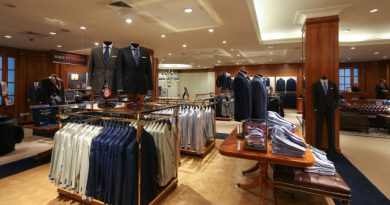Clicks Fast Overtaking Bricks in Fashion, Luxury Arena Says McKinsey – WWD
LONDON — The online juggernaut will gain steam in 2021, and beyond, with accelerating sales, a “war” for digital talent, and pressure on fashion and luxury brands to rethink the role of their physical stores, according to new research from McKinsey & Co.
The online channel has notched seven years of growth in nine months due to a spike in luxury consumers shopping from home, and in their home markets, according to Anita Balchandani, a McKinsey partner who heads the consultancy’s apparel, fashion and luxury business in the U.K. and EMEA.
Balchandani presented the findings of the report, “Taking stock of the apparel, fashion and luxury sector,” during a virtual roundtable discussion on Wednesday, and covered a variety of consumer trends in fashion and luxury worldwide.
In addition to the growing power of online, Balchandani pointed to a strong rebound in China next year, compared with the U.K., Europe and the U.S., and surveyed the damage that the COVID-19 pandemic has wrought during what has been a “remarkable year” for the industry.
Recovery, she said, will be driven by an accelerated demand for online fashion.
She noted that online fashion sales channels exploded in popularity this year, stealing market share from physical stores, which were dark during the pandemic.
In the U.K., online channels accounted for 41 percent of sales, up from 27 percent in 2019; in China they grew to 40 percent from 33 percent; in the U.S., they rose to 37 percent from 22 percent, and in the European Union they reached 26 percent from 16 percent.
By category, accessories has seen an 80 percent rise in customers making purchases online during the pandemic; jewelry witnessed a 41 percent rise; footwear 51 percent, and apparel 43 percent.
“We have seen staggering amounts of growth in the number of consumers purchasing mostly, or entirely, online as a consequence of spending more time at home. Even when the stores reopened we saw growth in the store channel, and online as well,” said Balchandani.
“We’ve seen more than seven years of online growth in nine months, and we think that opens a huge opportunity for brands and businesses to really pivot and reposition themselves” in the post-COVID era.
Balchandani added that luxury fashion businesses had proven more adept at working their digital channels during the crisis, much more so than their mass-market competitors.
Although she did not name names, Primark was caught short earlier this year because it does not sell online. In the spring, as lockdown took hold in the U.K., Europe and the U.S., Primark was forced to shut all of its 376 stores in 12 countries and to cancel all future orders.
The company, which does not sell online, said in March the closures would represent a net sales loss of some 650 million pounds a month.
Looking ahead, online shopping will remain wildly popular among consumers, regardless of how, and when, physical stores reopen. In 2021, McKinsey estimates that online will account for 37 percent of fashion and luxury retail sales, both in the U.K. and in China. In the U.S., online will account for 34 percent of sales and in the EU they’ll make up 22 percent.
McKinsey’s findings should come as no surprise: Businesses including Amazon Luxury Stores launched just a few months ago, promising designer and beauty brands access to its vast pool of Prime consumers, while other fashion brands have been taking advantage of the online surge, opening shop fronts on Farfetch or Amazon.com or ramping up their direct-to-consumer businesses in a bid to capture the attention of house-bound shoppers.
Balchandani believes that as a result of the digital frenzy and brands’ effort to win in the space, there will be “a war for digital talent, who can bring data science and algorithms together with art, which is the lifeblood of the industry. We think that war will be absolutely key” going forward, she said.
In a devastating year for business, online wasn’t the only bright spot. In some regions, the domestic consumer has helped to offset the decline in spend by international tourists.
The report noted that the impact of COVID-19 on luxury sales in the U.K. has been less severe than for its European neighbors due to a higher share of domestic spend, which accounts for about 60 percent of the total. International luxury spending in the U.K. generates the remaining 40 percent.
Nonetheless, it has been a brutal year: The U.K. luxury sector has lost about 32 percent, or more than 4 billion pounds, so far this year due to the pandemic.
The upcoming holiday season can’t even begin to compensate for that loss, with McKinsey projecting a 62 percent decline in U.K. footfall forecast between Nov. 22 and Dec. 22.
According to the report, Chinese luxury consumers are expected to continue their focus on domestic spending in 2021. In China, luxury sales are set to rise 5 to 10 percent in 2020, and 28 to 33 percent in 2021.
In Europe and the U.S., meanwhile, sales will recover, but not return to growth. In 2021, sales in the U.S. will be down 5 to 10 percent, compared with minus 18 to 23 percent in the U.K., and minus-22 to 27 percent in the EU.
The report said the downturn will continue into 2022, with recovery taking time and varying by region, with industry consolidation to be another big theme going forward. “We’ll see the gap widen between ‘the Super Winners’ and the rest as the strongest companies continue to grow their market share.”
Asked about how brands and retailers will manage the tightrope walk of physical versus digital, she said there was much to be done. They’ll have to take a cold look at their store estates, decide where they want to remain and rebalance their portfolios.
Balchandani added that retailers will also have to ponder how to marry physical with digital because “consumers see the brand, rather than the channel,” so they should be thinking about how to extend shop-floor service experiences into people’s homes.
They should also look at some stores as fulfillment centers. She didn’t mention specifics, but some brands are already doing this with online services such as Toshi that allow orders to be fulfilled straight from the shop floor.
McKinsey & Co. is set to release a separate “State of Fashion” report on Dec. 2.




